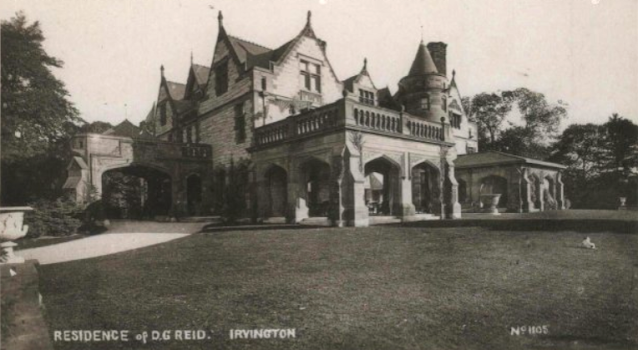Richmond Hill: Home to titans of industry, medicine, education
 |
| A postcard c. 1910 shows the “Richmond Hill” Gilded Age mansion near the southeast corner of Harriman Road and South Broadway, Irvington. |
Warner made his fortune by redesigning the corset to improve women’s health and co-founding with his brother Ira De Ver Warner, M.D., Warner Brothers Corset Manufacturers which made the new product.
The estate was later purchased by American Tin Plate Company co-founder Daniel Gray Reid, known as the "Tin Plate King." Reid eventually rolled his company into U.S. Steel, getting $18 million from J.P. Morgan for the company -- $568 million today -- in 1901.
Reid expanded the estate to include the southeast corner of Harriman Road and South Broadway when he purchased the campus of the Bennett School for Girls. The school, created in Irvington in 1890, moved to Millbrook, N.Y., in 1907 where it became Bennett College (which closed in 1978).
Reid tore down the school buildings and created sweeping lawns from the estate’s gate at Harriman and Broadway up to the mansion on the hill.
 |
A postcard ca. 1915 shows the Garden of the Lions and the clock tower overlooking it at the D.G. Reid estate in Irvington. |
At the time it was auctioned off by Reid's estate in 1928, the estate included the property at the southeast corner of the Harriman Road and South Broadway intersection plus the former estates of William F. Drake (Glenarm) and architect A.J. Manning between Station Road and Dows Lane that now make up Memorial Park.
The combined properties included a large stone garage, two large cottages, numerous outbuildings, formal gardens and tennis courts.
To put that in perspective, a 2-story stables with horses, carriages and cars on the ground floor and coachmen, grooms and other servants on the second was the norm for the richest of the rich of the Gilded Age. Reid kept up to 14 carriages and cars on the ground floor, walked horses up a ramp to a 16-stall second floor and housed his coachmen, grooms and other servants on the third floor.
For good measure, he had a bowling alley and billiard room installed below ground. The stables building was turned into a school after Reid's death and is now part of the New York School of Interior Design.
New York Yankees fans might remember Reid’s grandson, Daniel Reid Topping. Dan Topping was part owner and president of the Yankees from 1945 to 1964 when his ownership group was bought out by CBS.
Charles William Mitchell bought the estate in 1920 and sold it in 1931 to American Tobacco Company president George Washington Hill. It went on to be sold again in 1942, becoming the home of North American Philips Co., an electronics manufacturer, until 1965 and finally Yeshiva Ohel Schmuel, a rabbinical school, before being destroyed by fire in 1979 and redeveloped as Richmond Hill condominiums.
Hill was the tobacco magnate behind the skyrocketing growth of cigarette smoking in the U.S. in the first half of the 20th century. Hill hired public relations expert Edward Bernays to reverse the national taboo against women smoking in public, which he did successfully by his advertising campaign beginning in 1927.
When he introduced Lucky Strike cigarettes in 1917, Americans were smoking about 30 billion cigarettes a year. By the time he died in 1946 at age 61, that number had grown tenfold to 300 billion cigarettes a year.
Under Hill’s leadership, American Tobacco sponsored the giant radio programs “Your Hit Parade” and “The Jack Benny Show” and became an early sponsor of Frank Sinatra.
 |
The Daniel G. Reid estate is shown in a 1911 George Washington Brumley map. Park Avenue at left is now Harriman Road. Broadway runs below the estate across the lower quarter of the map when it extended west across Broadway into what is now part of Irvington's Memorial Park. * Click here for links to other Gilded Age stories by this author |












Interesting research. My grandfather founded Royer& Roger's. A Park Avenue advertising firm. I spent many years with him as an older man recalling his excitement of developing his company. He did work for Hills American Tobacco. He often would ride to NYC with Hill.
ReplyDelete